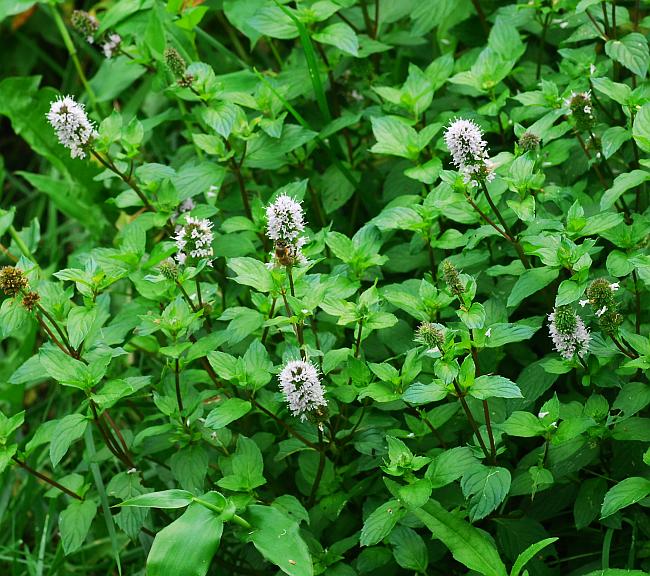Mentha piperita L.
Peppermint

Introduced
CC = n/a
CW =
MOC = 1
© DETenaglia
Mentha piperita L.Peppermint | |
 |
Introduced CC = n/a CW = MOC = 1 |
© DETenaglia |
|
Family - Lamiaceae Habit - Rhizomatous perennial forb, strongly fragrant when bruised. Stems - Ascending to erect, to 90 cm, sometimes from a spreading base, multiple from the base, from fibrous roots, branching, rooting at the nodes, 4-angled, glabrous or nearly so.
Leaves - Opposite, simple, petiolate. Petioles to 1.5 cm long, glabrous to sparsely pubescent. Blades to 7 cm long, mostly glabrous but with some pubescence on midrib below, ovate to elliptic, rounded at the base to slightly tapering, the margins sharply toothed. Veins anastomosing, depressed adaxially, expressed abaxially.
Inflorescence - Mainly terminal, elongate, dense to open spikelike racemes with 5 to numerous closely to more openly spaced nodes, the bracteal leaves inconspicuous, shorter than to only slightly longer than the flower clusters, occasionally also with a few headlike clusters or short spikes on short stalks from the axils of the upper foliage leaves.
Flowers - Calyces 3-4 mm long, 10-ribbed, 5-lobed, often hairy above the midpoint and along the lobe margins, the outer surface often also with sessile glands. Corollas 4-lobed (weakly bilabiate), 1.7-4.0 mm long, white to lavender or light pink, glabrous internally and externally, the lobes subequal, rounded at the apex. Stamens 4, adnate at the apex of the corolla tube, alternating with the corolla lobes, included. Filaments white, 0.5 mm long. Anthers orange, 0.4 mm long. Ovary superior, deeply 4-lobed, glabrous, green, 0.6 mm broad, subtended by a thick green nectary. Style white, glabrous, 5 mm long, exserted. Stigma 2-lobed.
Fruits - Nutlets 0.7-1.0 mm, yellowish brown or more commonly dark brown to black, often not produced. Flowering - June - October. Habitat - Wet ground of meadows, spring branches, streams, pond margins, sloughs, ditches, roadsides, railroads. Origin - Native to Europe. Lookalikes - M. spicata. Other info. This species occurs in somewhat scattered form across much of Missouri, most commonly south of the Missouri River. It is also found throughout most of the continental U.S., most commonly by far in the northeastern quadrant and the west coastal states. It is recognized by its opposite, toothed leaves, square stems, and elongate inflorescences having multiple whorls. Extensive cultivation and breeding, along with the plant's natural predilection for hybridization and polyploidy have given rise to a taxonomically confusing array of morphologies. Many authors refer to this plant as Mentha x piperita, a hybrid between M. spicata (spearmint) and M. aquatica (water mint). It is always associated with wet conditions. Photographs taken at the Peck Ranch Wildlife Refuge, Carter County, MO., 7-19-01 (DETenaglia); also at Cuivre River State Park, Lincoln County, MO, 8-15-2014 (SRTurner). |